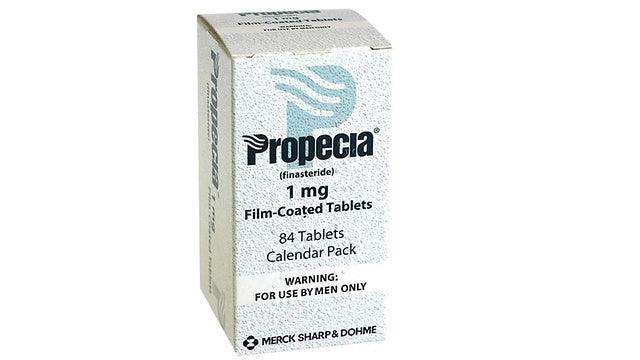Propecia: Hair Loss Treatment
What is Propecia (Finasteride) used for?
Propecia, the brand name for finasteride, serves as a go-to pharmaceutical solution for male pattern hair loss. Finasteride inhibits an enzyme known as 5-alpha-reductase, effectively reducing the conversion of testosterone to DHT - a hormone that causes male pattern baldness, as explained by Dr James Williams, a renowned dermatologist. It takes about 3 to 6 months for the full effects to be seen, highlighting the need for patient adherence to the treatment regimen, according to the NHS.
How does Propecia work?
Propecia works at the hormonal level to combat hair loss, by reducing the production of DHT, a derivative of testosterone identified as the main culprit in the hair-thinning process. DHT miniaturises hair follicles, leading to thinner and shorter hair, as explained by the American Hair Loss Association. Propecia effectively slows or reverses hair miniaturisation by lowering DHT levels, thereby promoting hair growth and density.
Is Minoxidil the same as Finasteride?
No, Minoxidil and Finasteride are not the same, the biggest difference is how they each combat hair loss. While finasteride reduces DHT production to slow hair loss, Minoxidil, a vasodilator, increases blood flow to the hair follicles to stimulate hair growth. Both treatments have proven effective, but a 2019 study in the Journal of Dermatological Treatment suggests they offer optimal results when used in combination. Consult a healthcare provider for recommendations before use.
Propecia Dosages and Administration
Propecia is typically administered in a 1mg daily tablet for the treatment of male pattern hair loss. The dosage, as recommended by the British Association of Dermatologists, is effective in slowing hair loss and promoting hair regrowth. Patients must remain consistent with the dosage as increased amounts do not necessarily lead to better results but potentially increase the risk of side effects.
What Propecia dosages are available?
Finasteride, the active ingredient in Propecia, is available in two main strengths - 1mg and 5mg. However, the 1mg dosage is the standard for treating male pattern hair loss. The 5mg strength, often marketed under the brand name Proscar, is typically used for benign prostatic hyperplasia (BPH). Always consult a healthcare provider for the appropriate dosage, as per the advice given by The British National Formulary.
How to take Propecia?
Propecia is an oral medication intended to be taken once daily, with or without meals. Tablets must be swallowed whole and not crushed or broken. Consistent use of Propecia is crucial for optimal results, as stated by Dr Paul Farrant, a consultant dermatologist. It is important to note that it takes a few months before visible improvements are noticed.
When to take Propecia?
The best time to take Propecia is at a consistent time each day, to help maintain a steady level of the drug in the body and optimise its effectiveness. The medication is taken with or without food, as food does not significantly affect absorption. Maintaining a regular schedule is important for the effectiveness of the medication, as noted by the Medicines and Healthcare products Regulatory Agency (MHRA). However, if a dose is missed, it's advised not to take an extra dose the next day - just continue with the regular schedule.
Propecia Tablets Price
The price of Propecia varies depending on the pharmacy, the current price is around £40-£55 per month supply in the UK.
Propecia Effectiveness
How effective is Propecia?
When used consistently, Propecia is effective in producing improvements in 9 out of 10 men, with about 66% seeing new hair regrowth. Propecia demonstrates high effectiveness in the treatment of male pattern baldness. Furthermore, more than two-thirds of men using Propecia experienced some degree of hair regrowth, according to a meta-analysis in the International Journal of Dermatology.
What should I do if Propecia does not work?
If Propecia does not work after a year of consistent use, discussing other options with a healthcare provider is advisable. Other treatments, such as minoxidil or hair transplant surgery, are considered, knowing each individual's medical history allows a doctor to make better recommendations.
Does Propecia regrow hair?
Yes, Propecia stimulates hair regrowth. While its primary purpose is to prevent further hair loss, many men have reported regrowth of hair while on the medication. About 48% of men treated with Propecia experienced some hair regrowth after a year of treatment, as found in a study published in the Journal of the American Academy of Dermatology.
Does Propecia thicken thinning hair?
Yes, Propecia has been shown to increase hair thickness by reducing the miniaturisation of hair follicles. In addition to promoting hair regrowth, Propecia increases the diameter of existing hair strands, effectively thickening the hair, as found in a research by the Journal of the American Academy of Dermatology.
Does Propecia work on temples?
The effectiveness of Propecia is primarily noted in the mid-scalp and crown areas, however, some users have reported improvements in the temple areas. Propecia potentially slows hair loss and promotes regrowth at the temples, but results are highly variable and less predictable than in other areas, as found in a report in the Dermatology and Therapy journal.
Does Propecia work for a receding hairline?
Propecia is primarily used for hair loss at the vertex and the anterior mid-scalp area, while it's not specifically indicated for a receding hairline, some men have reported improvements in this area. While Propecia has demonstrated effectiveness in many areas of the scalp, results on the hairline are less consistent, as explained by Dr Susan Holmes, a hair loss specialist.
Propecia Shedding
An initial increase in hair shedding may occur within the first few months of starting Propecia. Shedding is often a good sign and indicates that the medication is working. The initial shedding is due to hair follicles reacting to the medication and shifting from a resting phase into a growth phase, as explained by Dr David Fenton, a leading dermatologist.
How long does Propecia take to work?
Propecia usually takes about three to six months to see noticeable results. Some men may need to take Propecia for six months or more before they see significant results, as pointed out by the British Association of Dermatologists.
Does Propecia help hair growth?
Yes, finasteride, the active ingredient in Propecia, has been shown to promote hair growth. Finasteride effectively stimulates hair growth by reversing the miniaturisation of hair follicles, as found in studies published in the Journal of Clinical and Aesthetic Dermatology.
Does Propecia cause weight gain?
No, weight gain is not a commonly reported side effect of Propecia. The majority of side effects are related to sexual function, and weight changes are not prominently listed, according to the Medicines and Healthcare products Regulatory Agency (MHRA).
Does Propecia change sexual function?
Yes, changes in sexual function are among the most widely reported side effects of Propecia. Some men may experience decreased libido, erectile dysfunction, or changes in ejaculation. A study in JAMA Dermatology found that these side effects occur in a small percentage of men and often resolve either during continued treatment or after stopping the medication.
Propecia and erectile dysfunction
Yes, erectile dysfunction is a potential side effect of Propecia occurring in 1.35 of users, though it affects a small percentage of users. Less than 2% of men experience the side effect, according to research published in PeerJ. Importantly, these effects often resolve after discontinuing the medication, but in rare cases, they may persist.
Does Propecia lower testosterone?
No, Propecia does not lower levels of testosterone. In fact, by inhibiting the conversion of testosterone to DHT, it may slightly increase testosterone levels. Propecia targets DHT specifically and has no significant effect on circulating testosterone levels, as explained by Dr David Fenton, a dermatology specialist.
What are the possible side effects associated with Propecia?
Possible side effects of Propecia include changes in sexual function such as decreased libido, erectile dysfunction, and changes in ejaculation. Other less common side effects may include breast tenderness or enlargement, rashes, and depression. However, these side effects are rare, and most men taking Propecia do not experience any adverse effects. For a comprehensive list, refer to the NHS page on finasteride or consult a doctor.
How long do the side effects of Propecia last?
Most side effects of Propecia resolve within a few weeks to months after discontinuing the medication. However, in rare cases, some individuals may experience persistent side effects, often referred to as a post-finasteride syndrome. Persistent side effects are rare, and more research is needed to understand why they occur in certain individuals, according to a study in the Journal of Sexual Medicine. Always consult a healthcare provider if side effects persist after discontinuing the medication.
Can you take paracetamol with Propecia?
Yes, Paracetamol is generally safe to take with Propecia. There's no known interaction between these two medications, as the British National Formulary affirmed. However, it is always advisable to consult a healthcare provider before combining medications.
Can you drink alcohol when taking Propecia?
Yes, moderate consumption of alcohol does not directly interact with Propecia. However, excessive alcohol consumption has potential adverse effects on hair health and exacerbates other Propecia side effects. Alcohol potentially contributes to hair loss and other health conditions, as supported by the Alcohol and Drug Foundation.
Propecia: Buying and Availability
Is Propecia over the counter in the UK?
No, Propecia is not available over the counter in the UK. Propecia is a prescription medication, and thus, requires a prescription from a registered healthcare provider. Individuals must consult with a healthcare provider to obtain a prescription.
Can I buy Propecia online?
Yes, Propecia can be purchased online from registered pharmacies following an online consultation with a healthcare provider. The General Pharmaceutical Council provides a list of registered online pharmacies in the UK. It is essential to ensure the pharmacy is registered to ensure the medication is genuine and safe to use.
Can I buy Propecia Amazon?
No, Amazon does not sell prescription medications like Propecia. Always ensure medications are purchased from a reputable source and have a valid prescription.
Does Boots sell Propecia?
Yes, Propecia is available from Boots Pharmacy with a valid prescription in the UK. Boots offers both in-store and online services for the fulfilment of prescriptions.
Finasteride Superdrug
Superdrug, a popular pharmacy chain in the UK, offers finasteride (the generic form of Propecia) through their health service. A prescription is required, and is obtained through an online consultation with one of Superdrug's healthcare providers.
Propecia NHS
Propecia is not routinely available on the NHS for treating male pattern baldness, as it's considered a cosmetic issue. However, finasteride, the active ingredient in Propecia, is available on the NHS to treat conditions like benign prostatic hyperplasia. For more information, refer to the NHS page on finasteride.
Propecia Alternatives
Propecia vs. Minoxidil
Propecia and Minoxidil represent two of the most popular treatments for hair loss, but they operate differently. Propecia works systemically, altering hormonal pathways to reduce hair loss, while Minoxidil acts locally to stimulate hair growth. Both treatments prove effective, yet their combined use can lead to better results, according to a 2019 study published in Dermatologic Therapy. Nevertheless, each has potential side effects that users need to consider and consult with a provider for further advice.
Propecia vs. Dutasteride
Propecia and Dutasteride, another medication used to treat hair loss, have a similar mechanism of action. Both inhibit the 5-alpha reductase enzyme, but dutasteride inhibits both Type I and Type II of the enzyme, whereas finasteride mainly inhibits Type II. Dutasteride might be more effective than finasteride in promoting hair growth, as per a study in the Journal of Clinical and Aesthetic Dermatology. However, it potentially causes more side effects, making it a second-line treatment option.
Propecia vs. Aindeem
Aindeem, like Propecia, contains finasteride and is used in the treatment of male pattern baldness. Their effectiveness and potential side effects are similar since they contain the same active ingredient. However, brand preferences may vary among patients, depending on factors such as pricing and availability, as pointed out by Dr Sarah Marshall in the British Journal of Dermatology.



















